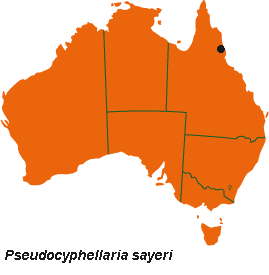



Australian Biological Resources Study
| Checklist of the Lichens of Australia and its Island Territories | ||
| Introduction | A–D | E–O | P–R | S–Z | Oceanic Islands | References | ||
| Pseudocyphellaria sayeri D.J.Galloway | ||
| Lichenologist 29: 600 (1997); Stictina fragillima var. linearis Müll.Arg., Flora 71: 23 (1888); Sticta fragillima f. linearis (Müll.Arg.) Zahlbr., Cat. Lich. Univ. 3: 382 (1925). T: Mt Bellenden Ker, Qld, 1887, W.A.Sayer; holo: G; iso: G 001994, MEL. | ||
| Thallus rosette-forming to irregularly spreading, loosely attached centrally, 2–5 (–10) cm wide. Lobes very narrow, 0.5–1.5 (–2.5) cm long, 0.5–1.5 mm wide at apices, to 3 mm wide centrally, repeatedly dichotomously or trichotomously branching, very fragile and brittle when dry; apices only free and divergent, centrally complex-entangled and forming a dense tangled mat; lobe margins entire, not thickened above or below. Upper surface pale grey or olivaceous when dry, dark blue-green or blue-black when wet, plane to subcanaliculate to irregularly punctate-impressed, smooth, matt or glossy; without isidia, maculae, phyllidia, pseudocyphellae or soredia. Medulla white. Photobiont Nostoc. Lower surface pale cream at margins, red-brown centrally, entirely glabrous, rarely with a very thin and patchy tomentum centrally, Pseudocyphellae rather widely scattered, minute, fleck-like, plane, white. Apothecia not seen. CHEMISTRY: 7β-acetoxyhopane-22-ol, hopane-7β, 22-diol (trace) and hopane-15α, 22-diol. |  |
|
| A rare Australian endemic known only from north-eastern Qld; grows on bark at an altitude of c. 1200 m. | ||
| Galloway et al. (2001) | ||
| Checklist Index |
| Introduction | A–D | E–O | P–R | S–Z | Oceanic Islands | References |
This work is copyright. Apart from any use as permitted under the Copyright Act 1968, no part may be reproduced by any process without prior written permission from Australian Biological Resources Study. Requests and inquiries concerning reproduction and rights should be addressed in the first instance to Dr P. McCarthy. These pages may not be displayed on, or downloaded to, any other server without the express permission of ABRS.